| Listing 1 - 10 of 44 | << page >> |
Sort by
|
Book
ISBN: 3838273389 9783838273389 Year: 2019 Publisher: Stuttgart : Ibidem-Verlag,
Abstract | Keywords | Export | Availability | Bookmark
 Loading...
Loading...Choose an application
- Reference Manager
- EndNote
- RefWorks (Direct export to RefWorks)
Former Soviet republics --- CIS countries --- Commonwealth of Independent States countries --- Ex-Soviet republics --- Ex-Soviet states --- Former Soviet states --- New Independent States (Former Soviet republics) --- Newly Independent States (Former Soviet republics) --- NIS (Former Soviet republics) --- Emigration and immigration.
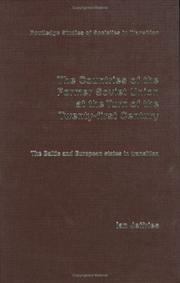
ISBN: 0203647548 1280036648 0415648963 0203686381 041525230X 042923466X 1134528264 9780203647547 9780415252300 9781134528264 9781134528219 1134528213 9781134528257 1134528256 9780415648967 9781280036644 Year: 2004 Volume: 22 Publisher: London Routledge
Abstract | Keywords | Export | Availability | Bookmark
 Loading...
Loading...Choose an application
- Reference Manager
- EndNote
- RefWorks (Direct export to RefWorks)
Offering a unique level of coverage, this book provides a comprehensive survey of the political and economic development of the countries of the former Soviet Union from the mid-1990s onwards.
Regions & Countries - Europe --- Business & Economics --- Russia & Former Soviet Republics --- Economic History --- History & Archaeology --- Former Soviet republics --- History. --- Economic conditions --- Politics and government. --- Economic order --- Baltic Area --- Russia --- CIS countries --- Commonwealth of Independent States countries --- Ex-Soviet republics --- Ex-Soviet states --- Former Soviet states --- New Independent States (Former Soviet republics) --- Newly Independent States (Former Soviet republics) --- NIS (Former Soviet republics)
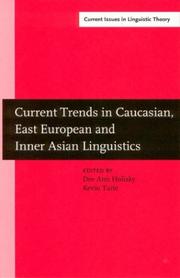
ISBN: 1588114619 9027247587 9789027247582 9786613312075 1283312077 9027275254 9781588114617 9789027275257 9781283312073 661331207X Year: 2003 Volume: 246 Publisher: Amsterdam John Benjamins
Abstract | Keywords | Export | Availability | Bookmark
 Loading...
Loading...Choose an application
- Reference Manager
- EndNote
- RefWorks (Direct export to RefWorks)
Former Soviet republics --- Ex-URSS --- Languages. --- Langues --- Languages --- Asian languages --- Russian language --- CIS countries --- Commonwealth of Independent States countries --- Ex-Soviet republics --- Ex-Soviet states --- Former Soviet states --- New Independent States (Former Soviet republics) --- Newly Independent States (Former Soviet republics) --- NIS (Former Soviet republics) --- Former Soviet republics - Languages
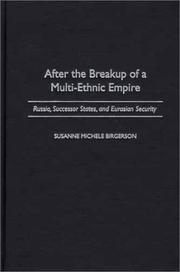
ISBN: 0275969509 0275969657 9780313073588 0313073589 9780275969509 9780275969653 Year: 2002 Publisher: Westport, Conn. Praeger
Abstract | Keywords | Export | Availability | Bookmark
 Loading...
Loading...Choose an application
- Reference Manager
- EndNote
- RefWorks (Direct export to RefWorks)
National security --- Post-communism --- World politics --- Sécurite nationale --- Postcommunisme --- Politique mondiale --- Former Soviet republics --- Ex-URSS --- Foreign relations. --- Politics and government. --- Relations extérieures --- Politique et gouvernement --- Sécurite nationale --- Relations extérieures --- CIS countries --- Commonwealth of Independent States countries --- Ex-Soviet republics --- Ex-Soviet states --- Former Soviet states --- New Independent States (Former Soviet republics) --- Newly Independent States (Former Soviet republics) --- NIS (Former Soviet republics)
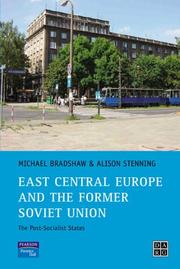
ISBN: 0130182524 1315847825 1317905024 1138166499 9781317905028 9780130182524 9781315847825 9781317905011 9781138166493 Year: 2014 Publisher: London
Abstract | Keywords | Export | Availability | Bookmark
 Loading...
Loading...Choose an application
- Reference Manager
- EndNote
- RefWorks (Direct export to RefWorks)
A comprehensive introduction to the important economic, social and political processes and development issues in this increasingly popular area of study. Employing a groundbreaking thematic approach the book centres its discussion on the interrelation between contemporary development theories and continuing transition issues in this huge and complex region.
Europe, Central --- Europe, Eastern --- Former Soviet republics --- Economic conditions. --- Social conditions. --- Economic conditions --- Social conditions --- Europe, Eastern - Economic conditions - 1989-. --- CIS countries --- Commonwealth of Independent States countries --- Ex-Soviet republics --- Ex-Soviet states --- Former Soviet states --- New Independent States (Former Soviet republics) --- Newly Independent States (Former Soviet republics) --- NIS (Former Soviet republics)

ISBN: 0585191751 9780585191751 0890967865 Year: 1998 Publisher: Texas Texas A & M University Press
Abstract | Keywords | Export | Availability | Bookmark
 Loading...
Loading...Choose an application
- Reference Manager
- EndNote
- RefWorks (Direct export to RefWorks)
From 1993 to 1995, the author, "traveled the former Soviet empire as head of the rule of law programs of the Warsaw Office of Democratic Institutions and Human Rights (ODIHR), part of the Organization fro Sceurity and Cooperation in Europe (OSCE). His primary task was to help the new nations of the region write new constitutions and modernize their judicial systems."
Post-communism --- Sociology & Social History --- Social Sciences --- Social Conditions --- Europe, Eastern --- Former Soviet republics --- CIS countries --- Commonwealth of Independent States countries --- Ex-Soviet republics --- Ex-Soviet states --- Former Soviet states --- New Independent States (Former Soviet republics) --- Newly Independent States (Former Soviet republics) --- NIS (Former Soviet republics) --- East Europe --- Eastern Europe --- Social conditions --- Social life and customs. --- Social conditions. --- capuccinia

ISBN: 128285500X 9786612855009 0773567127 9780773567122 9780773517172 0773517170 6612855002 Year: 1998 Publisher: Montreal Buffalo McGill-Queen's University Press
Abstract | Keywords | Export | Availability | Bookmark
 Loading...
Loading...Choose an application
- Reference Manager
- EndNote
- RefWorks (Direct export to RefWorks)
Chandler provides a comprehensive examination of border controls from the Bolshevik Revolution of 1917 to the collapse of the U.S.S.R. in 1991 and shows the continued importance of border controls for the newly independent Soviet successor states. She reveals the changing nature of Soviet border control policy, from the extreme Stalinist isolation of the 1930s to liberalization - and eventual instability - during perestroika in the late 1980s. Chandler argues that Communist ideology was not the only reason for the self-imposed isolation of the state and explores a complex, ever-changing set of political, inter-bureaucratic, and economic factors that combined to influence the Soviet Union's closed-border policies. She draws on social science theories of comparative institutional change and state formation to illuminate policies within the Soviet state, which has often been regarded as a unique case. By exploring why a political system that originally prided itself on its internationalism devoted such intense efforts to seal its society from the outside world, Institutions of Isolation provides a revealing case study of the strengths and weaknesses of the Soviet state.
Soviet Union --- Former Soviet republics --- CIS countries --- Commonwealth of Independent States countries --- Ex-Soviet republics --- Ex-Soviet states --- Former Soviet states --- New Independent States (Former Soviet republics) --- Newly Independent States (Former Soviet republics) --- NIS (Former Soviet republics) --- History. --- Boundaries. --- Foreign relations. --- Politics and government. --- Foreign relations --- Politics and government --- History --- Boundaries --- HISTORY / Russia & the Former Soviet Union.
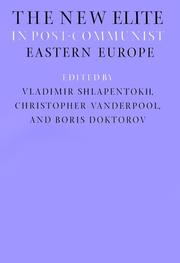
ISBN: 1603447202 058538035X 9780585380353 0890968950 9780890968956 9781603447201 Year: 1999 Publisher: College Station Texas A and M university press
Abstract | Keywords | Export | Availability | Bookmark
 Loading...
Loading...Choose an application
- Reference Manager
- EndNote
- RefWorks (Direct export to RefWorks)
Former Soviet republics --- CIS countries --- Commonwealth of Independent States countries --- Ex-Soviet republics --- Ex-Soviet states --- Former Soviet states --- New Independent States (Former Soviet republics) --- Newly Independent States (Former Soviet republics) --- NIS (Former Soviet republics) --- Politics and government --- #SBIB:324H41 --- #SBIB:328H262 --- #SBIB:328H27 --- Politieke structuren: elite --- Instellingen en beleid: Rusland en het GOS --- Instellingen en beleid: Midden- en Centraal Europa: algemeen
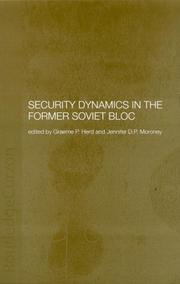
ISBN: 1138371033 1136497811 1315016125 9781136497810 129970008X 9781299700086 041529732X 9780415297325 041529732X 9780415297325 9781138371033 9781315016122 9781136497889 1136497889 Year: 2003 Publisher: London ; New York : RoutledgeCurzon,
Abstract | Keywords | Export | Availability | Bookmark
 Loading...
Loading...Choose an application
- Reference Manager
- EndNote
- RefWorks (Direct export to RefWorks)
Security Dynamics in the Former Soviet Bloc focuses on four former Soviet sub-regions (the Baltic Sea region, the Slavic republics, the Black Sea region, and Central Asia) to explore the degree to which 'democratic security', which includes de-politicisation of, and civilian oversight of, the military, resolution of conflicts by international cooperation, and involvement in international organisations. It examines how far states in these regions have developed cooperative foreign and security policies towards their immediate neighbours and key Western states and organisations, explores the interplay between internal and external aspects of democratic security building, and uses case-study examples to show how inter-state bi-lateral and multi-lateral relations are developing.
National security --- Post-communism --- Democratization --- Democratic consolidation --- Democratic transition --- Political science --- New democracies --- Former Soviet republics --- CIS countries --- Commonwealth of Independent States countries --- Ex-Soviet republics --- Ex-Soviet states --- Former Soviet states --- New Independent States (Former Soviet republics) --- Newly Independent States (Former Soviet republics) --- NIS (Former Soviet republics) --- Foreign relations. --- Politics and government.
Book
ISBN: 1479805394 1479892130 1479847739 Year: 2018 Publisher: New York, NY : New York University Press,
Abstract | Keywords | Export | Availability | Bookmark
 Loading...
Loading...Choose an application
- Reference Manager
- EndNote
- RefWorks (Direct export to RefWorks)
Explores the racialization of immigrants from post-Soviet states and the nuances of citizenship for this new diaspora. Mapping representations of post-1980s immigration from the former Soviet Union to the United States in interviews, reality TV shows, fiction, and memoirs, Claudia Sadowski-Smith shows how this nationally and ethnically diverse group is associated with idealized accounts of the assimilation and upward mobility of early twentieth-century arrivals from Europe. As it traces the contributions of historical Eastern European migration to the emergence of a white racial identity that continues to provide privileges to many post-Soviet migrants, the book places the post-USSR diaspora into larger discussions about the racialization of contemporary US immigrants under neoliberal conditions. The New Immigrant Whiteness argues that legal status on arrival––as participants in refugee, marriage, labor, and adoptive migration–– impacts post-Soviet immigrants’ encounters with growing socioeconomic inequalities and tightened immigration restrictions, as well as their attempts to construct transnational identities. The book examines how their perceived whiteness exposes post-Soviet family migrants to heightened expectations of assimilation, explores undocumented migration from the former Soviet Union, analyzes post-USSR immigrants’ attitudes toward anti-immigration laws that target Latina/os, and considers similarities between post-Soviet and Asian immigrants in their association with notions of upward immigrant mobility. A compelling and timely volume, The New Immigrant Whiteness offers a fresh perspective on race and immigration in the United States today.Explores the racialization of immigrants from post-Soviet states and the nuances of citizenship for this new diaspora. Mapping representations of post-1980s immigration from the former Soviet Union to the United States in interviews, reality TV shows, fiction, and memoirs, Claudia Sadowski-Smith shows how this nationally and ethnically diverse group is associated with idealized accounts of the assimilation and upward mobility of early twentieth-century arrivals from Europe. As it traces the contributions of historical Eastern European migration to the emergence of a white racial identity that continues to provide privileges to many post-Soviet migrants, the book places the post-USSR diaspora into larger discussions about the racialization of contemporary US immigrants under neoliberal conditions. The New Immigrant Whiteness argues that legal status on arrival––as participants in refugee, marriage, labor, and adoptive migration–– impacts post-Soviet immigrants’ encounters with growing socioeconomic inequalities and tightened immigration restrictions, as well as their attempts to construct transnational identities. The book examines how their perceived whiteness exposes post-Soviet family migrants to heightened expectations of assimilation, explores undocumented migration from the former Soviet Union, analyzes post-USSR immigrants’ attitudes toward anti-immigration laws that target Latina/os, and considers similarities between post-Soviet and Asian immigrants in their association with notions of upward immigrant mobility. A compelling and timely volume, The New Immigrant Whiteness offers a fresh perspective on race and immigration in the United States today.
Mass media and minorities --- Immigrants --- United States --- Former Soviet republics --- CIS countries --- Commonwealth of Independent States countries --- Ex-Soviet republics --- Ex-Soviet states --- Former Soviet states --- New Independent States (Former Soviet republics) --- Newly Independent States (Former Soviet republics) --- NIS (Former Soviet republics) --- Emigration and immigration. --- Immigration
| Listing 1 - 10 of 44 | << page >> |
Sort by
|

 Search
Search Feedback
Feedback About UniCat
About UniCat  Help
Help News
News